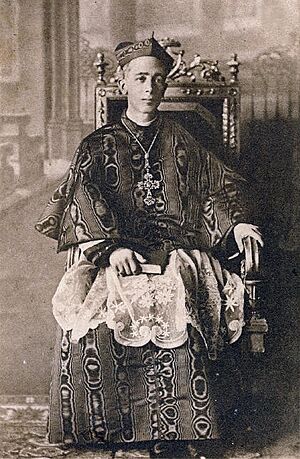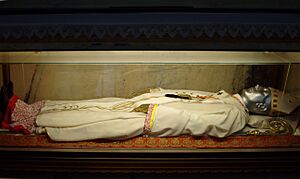Alfredo Ildefonso Schuster facts for kids
Quick facts for kids Blessed Alfredo Ildefonso Schuster O.S.B. |
|
|---|---|
| 'Cardinal Archbishop of Milan' |
|

Formal portrait, c. 1930
|
|
| Church | Roman Catholic Church |
| Archdiocese | Milan |
| See | Milan |
| Appointed | 26 June 1929 |
| Reign ended | 30 August 1954 |
| Predecessor | Eugenio Tosi |
| Successor | Giovanni Battista Montini |
| Other posts | Cardinal-Priest of Santi Silvestro e Martino ai Monti (1929–54) |
| Orders | |
| Ordination | 19 March 1904 |
| Consecration | 21 July 1929 by Pope Pius XI |
| Created Cardinal | 15 July 1929 |
| Rank | Cardinal-Priest |
| Personal details | |
| Birth name | Alfredo Ludovico Schuster |
| Born | 18 January 1880 Ospedale Santissimo Salvatore, Rome, Kingdom of Italy |
| Died | 30 August 1954 (aged 74) Archiepiscopal Seminary Pio XI, Venegono Inferiore, Varese, Italy |
| Buried | Cathedral of Milan |
| Previous post |
|
| Coat of arms | |
| Sainthood | |
| Feast day | 30 August |
| Venerated in | Roman Catholic Church |
| Beatified | 12 May 1996 Saint Peter's Square, Vatican City by Pope John Paul II |
| Attributes |
|
| Patronage | Archdiocese of Milan |
Alfredo Ildefonso Schuster was an important Italian Catholic leader. He was a member of the Benedictines, a group of monks. From 1929 until his death, he served as the Archbishop of Milan.
He was known as Ildefonso after he became a Benedictine monk. Before becoming an archbishop, he was an abbot, which is a leader of a monastery.
He led the church in Milan during World War II. At first, he seemed to support fascism, a type of government led by a strong ruler. But his opinions changed. He began to speak out against the anti-Christian ideas of Benito Mussolini's government.
In 1996, Alfredo Ildefonso Schuster was declared "Blessed" by the Catholic Church. This is a step towards becoming a saint.
Contents
Life of Alfredo Ildefonso Schuster
Early Life and Becoming a Priest
Alfredo Ludovico Schuster was born in Rome, Italy, in 1880. His father, Johann Schuster, was a tailor from Bavaria. His mother, Maria Anna Tutzer, was from Bolzano. Alfredo was baptized just two days after his birth.
When he was a child, he was briefly kidnapped, but the kidnapper was caught. His father passed away when Alfredo was nine years old.
Alfredo served as an altar boy at a church near Saint Peter's Basilica. He finished his high school studies at the Basilica of Saint Paul Outside the Walls. In 1898, he joined the Order of Saint Benedict there. He took the name Ildefonso.
He made his monastic vows in 1900. He then earned a doctorate in philosophy and later in theology. In 1904, he became a priest in Rome.
Becoming an Abbot
In 1908, Ildefonso Schuster became a master for new monks. He later became a prior in 1916. In 1918, he was chosen to be the abbot of Saint Paul Outside the Walls. An abbot is like a spiritual leader for a monastery.
He also held other important roles. He was the head of the Pontifical Oriental Institute from 1919 to 1922. He visited many religious schools in Italy. In 1926, he even led spiritual exercises for Angelo Giuseppe Roncalli, who later became Pope John XXIII.
Archbishop and Cardinal
In 1929, Schuster was chosen to be the Archbishop of Milan. This is a very important position in the Catholic Church. He was the first Italian bishop to take an oath of loyalty to the Italian state. This was because of a new agreement between the Church and the government.
Later that year, Pope Pius XI made him a cardinal. A cardinal is a high-ranking official in the Catholic Church.
As archbishop, Schuster ordained many new priests. He also consecrated 22 bishops. He visited the churches in his area five times. He wanted Christians to focus on holiness. He also supported the Catholic Action movement, which encouraged regular people to be active in their faith.
He also served as a special representative for the Pope on several occasions. In 1939, he took part in the meeting to elect a new Pope. This was just before World War II began. Some people even thought he might become the next Pope.
His Death and Burial
Alfredo Ildefonso Schuster passed away on August 30, 1954, from a heart problem. He was 74 years old. His funeral was led by Cardinal Angelo Giuseppe Roncalli, who later became Pope John XXIII.
He was buried in the main cathedral in Milan. When his tomb was opened in 1985, his body was found to be in good condition.
Honors and Awards
 He received an honor from the Order of the Holy Sepulchre.
He received an honor from the Order of the Holy Sepulchre. In 1933, he was honored by the Order of Malta.
In 1933, he was honored by the Order of Malta.
Alfredo Ildefonso Schuster and Fascism
There were discussions about Schuster's relationship with Italian fascism. While he showed some support for fascist goals early on, he later spoke out against the anti-Christian parts of fascism. He reportedly refused to attend ceremonies with Mussolini and criticized racist laws.
After a treaty was signed in 1929, Schuster believed the Church could work with the Fascist government. He thought this was possible if the Church's role was protected. In 1930, he even spoke about Mussolini having a "mission of salvation." This caused some confusion among Catholics.
Schuster also supported Italy's invasion of Ethiopia in 1935. He compared it to the Crusades. He saw it as a way to spread the Catholic faith. He blessed the Italian troops before they left.
However, his views changed around 1938. This was after Germany took over Austria and introduced racist laws. These ideas were then seen in Italy's own racial laws.
Meeting with Mussolini
On April 25, 1945, near the end of World War II, Cardinal Schuster hosted a meeting. It was between Italian resistance fighters and Mussolini in Milan. Schuster tried to help them reach a truce. However, Mussolini did not agree to surrender.
Schuster spoke with Mussolini during the meeting. He encouraged Mussolini to make peace with God. Mussolini was killed within a week after this meeting.
After the war, Schuster often warned people about the dangers of totalitarianism. This is a system where the government has total control. He said both communism and fascism were dangerous.
Beatification Process
The process to declare Schuster "Blessed" began in 1957. The Church looked into his life and writings. In 1994, Pope John Paul II confirmed that Schuster had lived a life of great virtue. He was then given the title "Venerable."
To become "Blessed," one miracle must be confirmed. A case was investigated where a nun, Maria Emilia Brusati, was cured of a serious eye disease called glaucoma. Doctors and theologians confirmed this healing was a miracle.
On May 12, 1996, Pope John Paul II officially declared Alfredo Ildefonso Schuster "Blessed." This ceremony took place in Saint Peter's Square in the Vatican City.
See Also
- Cardinal electors for the papal conclave, 1939
- Incorruptibility
- List of beatified people



